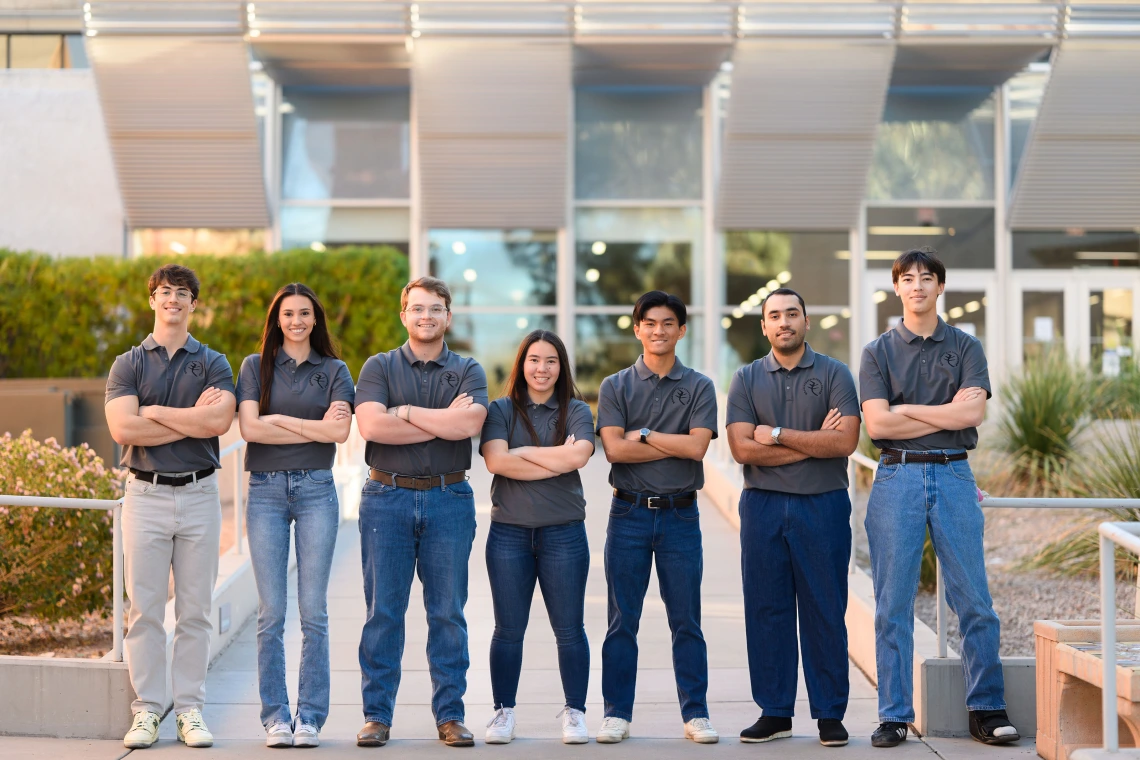Returning sponsor’s medical device gains commercialization traction
An Interdisciplinary Capstone team and a grant take the treatment closer to becoming a product for carpal tunnel syndrome patients.

Team 25013 members (left to right) Alejandro Moncada, Sabina Romero, Ryan Henry Walton Mitstifer, Brooklyn Fremin, Allen Lin, Ali Alrashidi and Eric Pineda are designing a new version of the carpal arch space augmentation, or CASA, device for treating CTS.
At the 2024 Craig M. Berge Design Day, two teams took home awards for their carpal arch space augmentation, or CASA, device prototypes. This academic year, Team 25013 is continuing the students’ progress and helping inventor Zong-Ming Li move the carpal tunnel treatment closer to the market.
Li, representing sponsor University of Arizona College of Medicine – Tucson, is eager to offer CTS patients an effective, noninvasive therapy. His wearable device applies specific force to the carpal tunnel within the wrist, thus expanding the tunnel and relieving symptoms including hand and arm pain, weakness, numbness and tingling. The National Institutes of Health estimates that CTS affects between 1% to 5% of American adults.
All former and future CASA prototypes rely on Li’s many years of research into optimizing this treatment through precise applications of force.
“The idea is the same, it’s just implemented differently,” said Li, a professor of biomedical engineering and the William and Sylvia Rubin Chair of Orthopedic Research.
Li started this year’s design project by presenting the pros and cons of the previous two teams’ prototypes to Team 25013.
“I have challenged the students to produce the most patient-friendly design possible,” he said.
The students strive to make the wrist brace non-intrusive while still providing the needed level of treatment, said student project leader Ryan Henry Walton Mitstifer. He and his teammates consider themselves lucky to have access to the prior teams’ results. However, the design Team 25013 will present at the 2025 Craig M. Berge Design Day is completely new.
“Ideas and generalized findings of their projects definitely still remain within our new models, but with a new, slim, and much more cost-effective design,” said the BME major.
The path to producing a product
Li has been working with Tech Launch Arizona, the university’s commercialization arm, to patent his invention and put it on the market. He hopes to join forces with an entrepreneur to launch a company that will offer CASA as a product patients buy for $200 or less.
Li got a boost in January from the Flinn Foundation, which supports Arizona biosciences, among other key priorities. The foundation chose CASA for a $100,000 2025 seed grant. The foundation selects grantees based on their demonstrated potential to translate findings into viable and impactful products and treatments.
The seed grant funds study into further design refinement, said Li. Once the design is perfected and approved by the Food and Drug Administration, and a company takes on its manufacturing and distribution, Li will realize his long-held goal to bring relief to millions.
“Our data shows the promise,” said Li, who has conducted several clinical trials and witnessed CASA’s efficacy firsthand. “I’m determined that now we have to move forward and bring this to the patient.”

